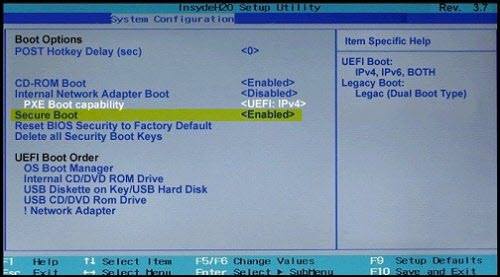
Click on Troubleshoot and then click on Advanced options.Ħ. Click on Restart Now under the Advanced Startup section.ĥ.

Follow the instructions below to fix the Windows 11 Secure boot requirement.Ĥ. If Secure boot is disabled, you can enable it in the UEFI firmware settings. How to Enable Secure Boot to Install Windows 11 You can use it to install Windows 11 on any unsupported PC. Once the process is complete, Rufus will create a Windows 11 bootable USB that can bypass the Secure boot and TPM 2.0 requirement. Click on the Start button and then click on OK to confirm.You can change the Advanced Format settings or keep them as they are.Rename the drive under the Volume label.Select the Extended Windows 11 Installation option under the Image option drop-down menu.Click on Select and locate the Windows 11 ISO file.Select the USB flash drive from the Device drop-down menu.Download the latest version of Rufus and open the application.The workaround is to use the Rufus tool to create a Windows 11 bootable USB that has Secure boot detection turned off.

An easier option would be to simply bypass the Secure boot requirement for installing Windows 11. However, that’s a complicated process and risks wiping out the entire system. If you are running Legacy BIOS, you have the option to switch to UEFI firmware type. How to Bypass Secure Boot to Install Windows 11 If it reads UEFI, that means Secure boot is available for the device regardless of whether it’s enabled or not.

While you’re at it, also check the BIOS mode that you’re running. In the system summary, look for “Secure Boot State.” Search for System Information and click on it.ģ. If getting this to work requires reinstalling everything (or requires doing things with a risk of damaging hardware or causing data loss) I probably wont bother and will just stick with Windows 10 for now but if there is something I can do that's easy and low-risk I would love to know about it.2. I have no other M.2 drives in this system, all the rest of my storage is SATA. different SSD) to make this work? Could my SSD be installed in the wrong slot on the motherboard (the motherboard has one slot next to the CPU and another one below the PCI-E x16 slot and that SSD is in the one below the PCI-E x16 slot with nothing in the slot closest to the CPU) How can I solve this so I can get secure boot working? (and then install Windows 11 when the option becomes available to do so)ĭo I need to wipe the disk and do a complete reinstall from scratch (windows and apps and etc) in order to get the BIOS to see this disk with CSM disabled?ĭo I need different hardware (e.g. I tried turning CSM off but when I did that, the system no longer saw my Crucial CT500P1SS8 NVME SSD (didn't even show up in the list of recognized drives anymore) and the system would no longer boot (just went back into the BIOS) and I had to turn CSM back on to get it to even see the disk, let alone boot from it.


 0 kommentar(er)
0 kommentar(er)
